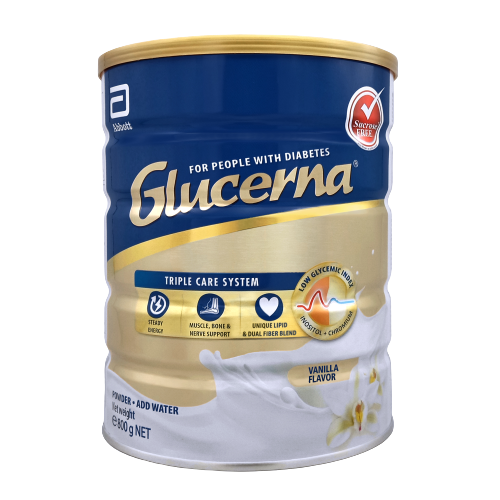Glucerna triple care
- Main Image
-

- Subtitle
- Complete and Balanced Nutrition For People with Diabetes
- Title
- Glucerna® Triple Care
- Detail Page Path
Inositol is a carbohydrate, produced by the body and found in some foods. Some consider it as a vitamin that belongs to the family of B-vitamins. Made in the liver and kidney, up to 4g of inositol is available each day for various roles in the body. 99% of inositol in the body is in the form of myo-inositol (MI).1
Intake of myo-inositol through diet is estimated to be up to 1g per day.2 Dietary sources include fruits, beans, grains and nuts. Fresh vegetables and fruits contain more than frozen or canned products.3
| Common Food Item | Serving Size | Myo-inositol Content Per Serve (mg) |
|---|---|---|
| Fresh Vegetables and Fruits | ||
| Green Beans | 1/2 Cup (100g) | 105 |
| Eggplant | 1/2 Cup (100g) | 84 |
| Cabbage | 1/2 Cup (100g) | 70 |
| Tomato | 1/2 Cup (100g) | 54 |
| Spinach | 1/2 Cup (100g) | 8 |
| Orange | 1 (100g) | 307 |
| Grapefruit | 1/2 (100g) | 199 |
| Kiwi | 1/2 Cup (100g) | 136 |
| Watermelon | 1 Cup (100g) | 62 |
| Honeydew | 1/8 (100g) | 46 |
| Apple (Rome) | 1 Medium (80g) | 12 |
| Dairy | ||
| Plain Yoghurt | 1 Cup (240g) | 14.4 |
| Chocolate Milk (Low fat) | 1 Cup (240g) | 45.6 |
| Cheddar Cheese | 1 Oz (240g) | 2.7 |
| Grains | ||
| Bran Flakes | 1/2 Cup (20g) | 54.8 |
| Cooked Oatmeal (Instant) | 1/2 Cup (100g) | 34 |
| Mix Wholegrain Bread | 1 Slice (25g) | 11.8 |
| Nuts | ||
| Almonds | 8 Pieces (15g) | 41.7 |
| Peanuts | 12 Pieces (15g) | 20 |
| Cashew | 5 PIeces (15g) | 12.2 |
A growing body of research has investigated the association between inositol and diabetes.
Scientific studies to date have shown that inositol can mimic the actions of insulin activity and may increase insulin sensitivity. Inositol has been shown to lower fasting blood glucose and HbA1c. Inositol has been used as a supplement in treating polycystic ovary syndrome (PCOS), metabolic syndrome, and gestational diabetes (GDM).4 Inositol supplements are well tolerated.
Based on a 2019 study conducted on poorly controlled (HbA1c 7.0%-10%) T2DM patients on glucose lowering medication. The study was designed to measure the effect of Inositol on glycemic control, namely fasting blood glucose and HbA1c.
Patients were given Inositol, 2 times a day for a period of 3 months:
Results from the study saw use of Inositol resulting in significant benefits in glycemic control:
Consult your healthcare professionals on how inositol supplementation may support you in your diabetes management plan!
References:
^ Based on lower limit of RDA.
1 Owczarczyk-Saczonek A, Lahuta LB, Ligor M, Placek W, Górecki RJ, Buszewski B. The Healing-Promoting Properties of Selected Cyclitols-A Review. Nutrients. 2018;10(12):1891.
2 Corrado, F., D’Anna, R., Di Vieste, G., Giordano, D., Pintaudi, B., Santamaria, A. and Di Benedetto, A. (2011), The effect of myoinositol supplementation on insulin resistance in patients with gestational diabetes. Diabetic Medicine, 28: 972-975. doi:10.1111/j.1464-5491.2011.03284
3 Clements RS Jr, Darnell B. Myo-inositol content of common foods: development of a high-myo-inositol diet. Am J Clin Nutr. 1980;33(9):1954‐1967.
4 Pintaudi B, Di Vieste G, Bonomo M. The Effectiveness of Myo-Inositol and D-Chiro Inositol Treatment in Type 2 Diabetes. Int J Endocrinol. 2016;2016:9132052.
5 Clements, R.S., & Darnell, B. (1980). Myo-inositol content of common foods: development of a high-myo-inositol diet. The American journal of clinical nutrition, 33 9, 1954-67 .
SG.2022.29988.GLU.1 (V1.1)
Stay Connected